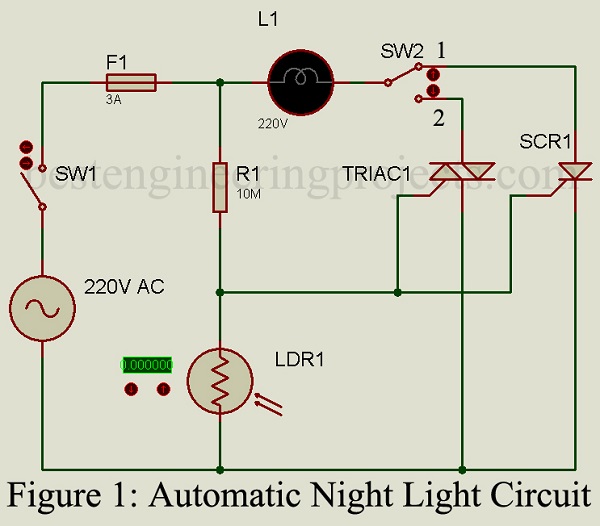The project “Automatic Night Lamp Circuit” is very simple and built around four major components i.e. TRIAC, SCR, LDR, and Resistor. The lamp used in this project is a porch light that would turn on automatically in dark (nighttime) and turn off in light (daytime).
Circuit Description of Automatic Night Lamp Circuit
The circuit of Automatic Night Lamp Circuit is used shown in figure 1. The circuit is very simple and straightforward that anyone has very little knowledge about TRIAC and SCR.
Silicon Controlled Rectifier | Automatic Night Lamp
SCR (Silicon Controlled Rectifier) is a PNPN silicon device with an end p-terminal forming the anode A, an end n-terminal forming the cathode k and a gate, called the cathode gate Ge, at the p-layer next to the cathode. SCR has two stable states namely ON state and OFF state. No intermediate state is possible. Thus, with the suitable forward voltage and gate current, SCR switches to the ON state and draws heavy current limited only by the resistor in the external circuit.
It remains in the ON state indefinitely. Only the SCR fires i.e. come in the ON state, gate loses all control. SCR can be turned OFF by reducing the supply voltage below the holding voltage VH i.e. reducing the device current below the holding current IH. This function of SCR is similar to that of a mechanical switch and hence SCR truly forms an electronic switch.
TRIAC | Automatic Night Lamp Circuit
Like SCR, TRIAC is also essentially a four-layer device and has three terminals only namely anode, cathode, and gate. But unlike SCR, triac is a bidirectional device. It can conduct in either direction and can block the voltage of either polarity. A voltage of either polarity can switch a triac from OFF state to ON state. Hence the function served by a TRIAC is essentially that of two SCRs connected in parallel but opposite directions. The gate terminal G makes ohmic contacts with both the n and p materials. This permits the trigger pulse of either polarity to start the flow of current.
LDR (Light Dependent Resistor) is a semiconductor device whose resistance change according to the intensity of light falling on it. The resistance will increase in absence of light on LDR and resistance will decrease in presence of light on LDR.
Working of Automatic Night Lamp Circuit
During daytime when an adequate amount of light fall on the LDR its resistance is very low. Let the switch SW2 be in position 1 (i.e. connected to SCR) and switch SW1 be closed. AC input voltage rises to 330 volts. The voltage is divided into two voltages because resistor R1 and LDR are connected in series. During the daytime, if the peak voltage is less than the breakdown voltage the SCR will remain off. When the light on LDR becomes low the resistance of LDR becomes high as a result SCR gate is triggered and the lap starts to glow. We know that SCR is only operated in the positive half cycle, as a result, the intensity of the bulb will reduce but it will boost the lifespan of the bulb.
To reduce this limitation, a TRIAC is used for this switch SW2 is moved to position 2. The brightness of the lamp will distinct increases.
Check out the other night/evening lamp circuit posted on bestengineeringprojects.com
- Automatic Night Lamp
- IC 555 Based Automatic evening lamp
- Light Sensor Switch Circuit using LDR and 741 IC
PARTS LIST OF AUTOMATIC NIGHT LAMP CIRCUIT
| Resistors (all ¼-watt, ± 5% Carbon) |
| R1 = 10 MΩ |
| Semiconductors |
| SCR1 = OE206 or SN206 or 2N2601 or TY6004 or any 2A, 600V SVR
TRIAC1 = SPT6M or 2N5757 or any 2A, 600V TRIAC LDR |
| Miscellaneous |
| SW1 = ON/OFF Switch
SW2 = SPDT switch L1 = 6W Lamp F1 = 3A rating Fuse |
Check out other top popular Articles :
Clock Signal Generator Circuit
